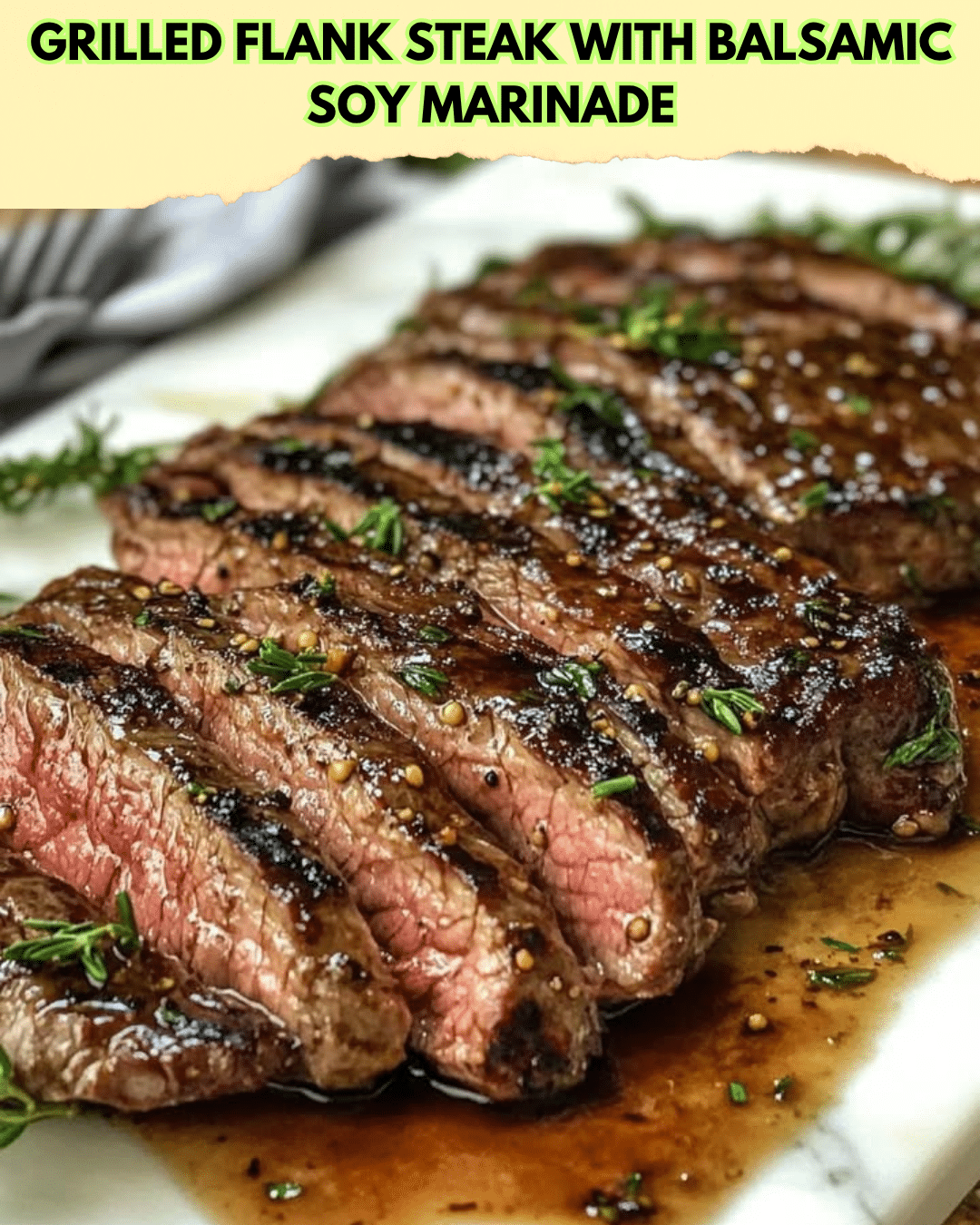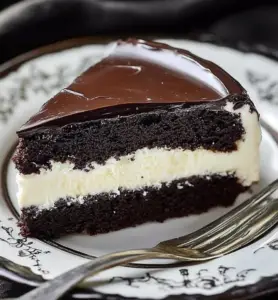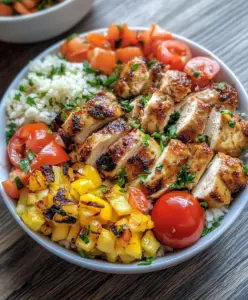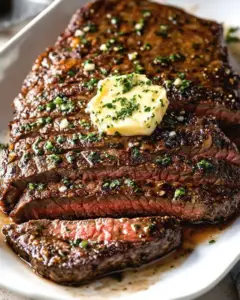Grilled Flank Steak with Balsamic Soy Marinade: A Flavorful Delight
Grilled Flank Steak with Balsamic Soy Marinade offers an extraordinary fusion of flavors that will tantalize your taste buds. This exquisite recipe marries the tender moments of marinated steak with the sweet and tangy kick of balsamic soy glaze. Whether you’re an experienced grill master or a home-cooking enthusiast, you’ll appreciate the richly layered flavors that define this dish. Savor each bite of this succulent steak recipe, perfect for family dinners or small gatherings with friends.
This recipe is not just about the taste; it’s a feast for the senses. The moment you place the marinated flank steak on the grill, a smoky aroma dances around, mingling with the savory balsamic soy marinade that caramelizes perfectly. The juicy steak offers a texture that is tender yet firm, making it an irresistible meal choice. Presented on a hearty wooden board with a sprinkle of fresh herbs, the grilled flank steak is visually appealing, inviting everyone at the table to indulge.
Quick Recipe Highlights
- Flavor Profile: The balsamic soy marinade infuses the steak with a balanced mix of tangy, sweet, and savory notes, creating a deliciously complex taste.
- Texture: The flank steak is tender and juicy after marinating, with a charred exterior that adds a slight crispiness to every bite.
- Aroma: A tantalizing blend of smoky grilled meat with aromatic balsamic and soy sauce notes fills the air as the steak cooks.
- Visual Appeal: The beautifully grilled steak showcases a rich, dark caramelized crust, complemented by the vibrant greens of garnishing herbs.
- Skill Level Needed: The recipe requires basic grilling techniques, perfect for cooks who are comfortable with heating control and timing on the grill.
- Special Equipment: A reliable grill and a meat thermometer for precise cooking are recommended to ensure perfect doneness.
Recipe Overview
- Difficulty Level: Although grilling can be a bit challenging for beginners, the marinade and cooking instructions make it accessible for home cooks of all levels.
- Category: This recipe belongs to the main course category, offering a protein-rich centerpiece for any meal plan.
- Cuisine: Rooted in a blend of American grilling techniques and Asian-inspired flavors, this steak celebrates culinary diversity.
- Cost: Flank steak is an affordable cut, and with the marinade ingredients being pantry staples, this dish is budget-friendly yet impressive.
- Season: Ideal for spring and summer when grilling outdoors is most enjoyable, but it’s a delightful dish year-round.
- Occasion: Perfect for weekend BBQs, casual weekday dinners, or celebratory gatherings, ensuring it’s a versatile recipe for any event.
Why You’ll Love This Recipe
The taste and texture of the Grilled Flank Steak with Balsamic Soy Marinade are unparalleled. Each bite bursts with flavor, thanks to the marinade’s savory and slightly sweet profile. The grilling process enhances the steak’s natural juices, creating a succulent and tenderly cooked piece of meat that pleases every palate.
Convenience is another reason you’ll appreciate this recipe. With just a short marinating time and a quick grill session, you can have a restaurant-quality dish ready in half an hour. It’s perfect for those busy days when you want something delicious but don’t have hours to spend in the kitchen.
Nutritionally, flank steak is a great source of protein and iron, giving you a hearty meal without excessive calories. The balsamic vinegar adds a touch of antioxidants, making this a health-conscious option for a balanced diet.
Socially, this recipe enhances gatherings with its ease of preparation and impressive presentation. It fits seamlessly into a wide array of side dishes, from colorful salads to robust roasted vegetables. Simply put, it makes entertaining elegantly simple.
Finally, cost-effectiveness is key. By choosing an economical cut like flank steak and relying on simple pantry staples for flavor, this dish proves that you don’t have to spend a fortune to enjoy a luxurious meal. Its accessibility and versatility make it a must-have in your recipe repertoire.
Historical Background and Cultural Significance
The origin of flank steak in culinary history is closely tied to American BBQ traditions, where this affordable and flavorful cut became a staple at cookouts and gatherings. Grilling, as a method, has been practiced for centuries, evolving from basic cooking over an open flame to sophisticated techniques enhancing flavors, such as marinating before cooking.
Culturally, the inclusion of balsamic vinegar and soy sauce adds an international twist, drawing from the rich culinary heritage of Italy and Asia. Balsamic vinegar, with its Italian roots, has been used for centuries in various dishes, while soy sauce brings a deeply savory essence from Asian cuisines, uniting different foodways.
The evolution of this recipe reflects the globalization of food, where cross-cultural influences enrich traditional methods. The blend of these diverse ingredients showcases a fusion of flavors and cooking techniques that have grown popular in modern cuisine.
Regional variations abound; some might use local herbs or spices to tailor the flavor profile further. In the southern U.S., for instance, you might find a spicier version using hot sauce or chili flakes to add heat to the dish. Each adaptation tells a story of regional preferences and culinary exploration.
Ingredient Deep Dive
The flank steak is central to this dish, known for being a relatively lean cut from the cow’s abdominal muscles. Its historical use in cheaper cuts has made it popular for marinating, allowing flavors to penetrate the fibers and tenderize the meat. It offers a robust taste and is a protein powerhouse, essential for a balanced diet.
Selection tips for flank steak include looking for a cut with good marbling and a deep red color, which indicates freshness. It’s crucial to score thin lines into the meat before marinating, allowing better flavor absorption. For storage, refrigerate raw steak in airtight packaging and use within a couple of days, or freeze for up to three months for longer storage.
Balsamic vinegar, a key ingredient, boasts a rich history as a specialty product from Modena, Italy. Its syrupy texture and sweet tanginess make it a coveted ingredient in gourmet dishes, adding depth and complexity. It serves as an antioxidant-rich component, enhancing dishes without unhealthy additives.
To store your balsamic, keep it in a cool, dark place, away from direct sunlight. Subtle substitutions, like using red wine vinegar or apple cider vinegar, can change the flavor profile, lending different notes to the marinade. Choose wisely based on your taste preference and ingredient availability.
Common Mistakes to Avoid
- Marinating too long can make the steak mushy, losing its natural texture. Aim for a 15-30 minute marination for optimal results.
- Grilling at too high a temperature will burn the marinade, leaving a bitter taste. Maintain a medium-high heat for even cooking.
- Not letting the steak rest after grilling can cause juices to run out, making the meat less juicy. Allow at least 5 minutes before slicing.
- Overcrowding the grill compromises the heat distribution, resulting in uneven cooking. Leave space between steaks.
- Using an improper grill is a common pitfall; opt for a sturdy gas or charcoal grill to achieve impactful searing marks.
- Slicing against the grain is crucial. Cutting with the grain results in tough, chewy slices that diminish the meal’s appeal.
- Skipping the meat thermometer step might lead to undercooked or overdone steak. Aim for medium-rare for best texture.
- Failing to adjust seasoning after the steak is grilled may lead to a bland taste; add a sprinkle of salt to enhance flavors.
- Using expired or low-quality soy sauce and balsamic vinegar can lessen the marinade’s impact. Ensure freshness for the best results.
Essential Techniques
Marination is the first critical technique to master. This process infuses the steak with flavors that enhance its natural taste. A great marinade not only flavors but also tenderizes the meat, breaking down tough fibers for a more enjoyable bite. Always marinate in the refrigerator to avoid any bacterial growth from ambient temperatures.
Grilling requires attention and practice to master. Begin by pre-heating the grill, ensuring it’s clean and lightly oiled to prevent sticking. Visual cues, like grill marks and color changes, indicate when to flip and when to probe temperatures. Listening to the sizzle when the steak hits the grates is another indicator of proper heat.
Resting the steak post-grilling allows the juices to redistribute, resulting in a juicy and tender cut. Resting is as paramount as grilling itself; skip this step, and you risk a dry steak. Wrap in foil to retain warmth while ensuring time to rest if needed.
Slicing against the grain is crucial for texture. Flank steak has visible fibers that can make it tough if sliced incorrectly. Identifying the grain and cutting perpendicularly ensures tender bites when serving, enhancing the overall experience.
Pro Tips for Perfect Grilled Flank Steak with Balsamic Soy Marinade
Select fresh and high-quality flank steak from a trusted butcher for optimal taste and texture.
Use a zip-lock bag for marinating to ensure even coverage and easy cleanup. Massage the marinade gently into the meat for best absorption.
Preheat your grill until it’s hot enough to ensure a perfect sear—this step caramelizes the marinade’s sugars, enhancing the steak’s flavor.
Allow leftovers to cool before storing to retain moisture during refrigeration. When reheating, use a low and slow method, like oven reheating, to maintain tenderness.
Experiment with garnishes, such as freshly chopped parsley or rosemary, to add freshness and color contrast to the final presentation.
Test various vinegars or citrus in the marinade to create different tangy profiles, personalizing the dish to your taste preferences.
Variations and Adaptations
Regional variations could include adding local or seasonal herbs, such as cilantro or thyme, to the marinade to complement the dish’s flavors.
In seasonal adaptations, consider switching beef cuts to what’s freshest and local, such as skirt steak or even sirloin for a leaner option.
For dietary modifications, a gluten-free soy sauce swap ensures the dish fits specific dietary needs without sacrificing flavor.
Explore flavor variations using honey or brown sugar in the marinade for a sweeter profile, enhancing the umami from soy sauce.
Texture modifications might involve dry-brining the steak before marinating for an added depth of flavor without excess moisture.
Consider presentation alternatives, arranging slices over a crisp bed of arugula or alongside roasted vegetables for a colorful, eye-catching plate.
Serving and Presentation Guide
Utilize plating techniques that showcase the steak as the focal point. Thinly slice against the grain, arranging slices in a fan-like pattern for impressive visual interest.
Garnishing ideas like fresh rosemary sprigs or grated lemon zest not only add vibrant color but also enhance the dish’s aroma with refreshing notes.
When serving, traditional accompaniments such as a classic Caesar salad or a side of grilled asparagus add balance to the meal’s richness.
Explore modern serving suggestions like using the steak as a filling in tacos or wraps, broadening its appeal to diverse meal settings.
Temperature considerations are key; serve the steak warm as the heat accentuates flavors. Offer sides that contrast temperatures, such as warm vegetable mixes with cooler green salads.
Portion control tips involve slicing the flank steak thinly, allowing guests to savor each bite while controlling the amount of protein consumed per serving.
Wine and Beverage Pairing
For wine pairings, consider a full-bodied red like a Cabernet Sauvignon, which complements the bold flavors found in the marinade and steak.
Non-alcoholic alternatives include a robust sparkling berry lemonade, offering a refreshing contrast to the meal’s richness.
Coffee or tea pairings such as a strong, unsweetened black tea can balance the savory flavor profile, providing an excellent finish.
Temperature considerations for your beverages involve serving them slightly chilled or at room temp to accentuate the steak’s warmth without overpowering it.
Always serve the pairings in appropriate glassware; the visual dimension adds to the dining sophistication, enhancing the overall meal experience.
Storage and Shelf Life
Post-cooking, store the flank steak in an airtight container or tightly wrapped in cling wrap to maintain moisture and prevent cross-contamination.
Temperature requirements indicate refrigerating cooked steak within two hours to keep it safe. Ideally, it should be eaten within 3-4 days.
Use appropriate containers like glass or BPA-free plastics to ensure no unwanted flavors or chemicals compromise the stored steak.
Signs of spoilage include an unpleasant odor or slimy texture. If noticed, it’s best to discard to avoid any health risk.
Reheating instructions involve using low temperatures, such as baking in an oven, to gently warm the steak without overcooking.
For freezing, slice the steak before packaging, and ensure it’s bundled tightly to eliminate air exposure, prolonging its storage life up to three months.
Make Ahead Strategies
Prep the marinade ahead of time and refrigerate it in a sealed container, saving on prep time when marinating the steak.
Store marinated steak in the refrigerator, ensuring it’s covered to avoid cross-contamination and maintain flavor integrity.
Understand that while refrigeration for an extended time can develop flavors, it risks altering texture. A balance of time is necessary for quality retention.
When assembling the meal, keep sides and garnishes within easy reach, pre-prepping them for quick plating after grilling.
For reheating guidelines, ensure gentle heat methods like steaming over high, quick bursts to preserve meat texture.
Fresh element additions are always recommended post-reheating, ensuring an appealing look and taste as if just prepared.
Scaling Instructions
Halving the recipe involves accurate measuring of marinade ingredients, cutting each ingredient by half for balance in smaller portions.
Doubling or tripling requires scaling up equipment sizes, such as a larger grill area, to accommodate additional steak pieces.
Equipment adjustments might include switching to more robust burners or using a chimney starter for larger charcoal setups to maintain heat consistency.
Timing modifications ensure steaks aren’t overcooked despite increased quantities; start checking earlier than expected to gauge doneness.
For storage considerations, ensure that each portion is securely sealed both refrigerated or frozen, ensuring no spoilage over extended periods.
Nutritional Deep Dive
A macro breakdown of flank steak highlights its high protein content, essential for muscle repair and growth. Balanced with the marinade, macros remain in favor of lean muscle-building.
Micronutrient analysis includes iron and vitamin B12 found in red meat, supporting energy and oxygen transport across the body.
The health benefits center around lean meat consumption, offering essential nutrients with lower fat content compared to other cuts.
Dietary considerations advise moderation for those needing low-sodium options; gradual ingredient tweaks can achieve a similar visual and taste appeal.
Portion analysis suggests serving no larger than 4-ounce portions per person, smart for both dietary management and ensuring no wastage.
Weight management tips involve removing visible fats or altering cooking techniques to reduce overall caloric density without sacrificing flavor.
Dietary Adaptations
For gluten-free diets, confirm the use of tamari soy sauce, which lacks wheat and maintains marinade flavor integrity.
Dairy-free adaptations are seamless as the recipe inherently contains no dairy, fitting well with lactose-intolerant meal plans.
Vegan options involve replacing steak with grilled tofu or tempeh, using identical marinade approaches to flavor plant proteins appealingly.
Low-carb approaches retain steak naturally; consider swapping side dish choices to cauliflower mash or zucchini noodles as satisfying fits.
Keto followers benefit from the high-fat content and natural flavors derived from meat, ensuring adherence to their chosen plan without need for significant recipe alteration.
Paleo protocol matches the recipe’s use of pure, unprocessed ingredients, with pasture-raised beef fitting within paleo ethos emphasizing quality.
Low-FODMAP meals require swaps like reduced balsamic vinegar or minimizing garlic ampoules, optimizing dish digestion while retaining deliciousness.
Troubleshooting Guide
Texture issues like toughness derive commonly from overcooking or improper slicing; rest and slice against the grain for desired tenderness.
Flavor balance is often resolved by adjusting marinade components, enhancing either sweet or savory touches with intended subtlety for a balanced palate.
Temperature discrepancies arise from unfamiliar grill equipment or varied meat thickness; using a thermometer clarifies adjustments for accurate heat levels.
Equipment challenges include substituted grilling methods like pan-searing or broiling when outdoor access is limited, adapting timing and techniques accordingly.
Ingredient substitutions maintain experience when primary items like vinegar or soy concerns suggest alternative experiments without flavor loss.
Timing essentials involve moving with precision at targeted stages, advancing preparations with reminders or alarms when multiple steps intersect.
Recipe Success Stories
Community feedback highlights how this recipe resonates broadly with families, becoming a staple for special weekends or casual gatherings alike, proving adaptability and persistent delight.
Variation successes engage enthusiastic cooks experimenting with additional herbs, extending the recipe freshness while adhering closely to core instructions.
Adaptation experiences include reader-driven swaps, featuring chicken or seafood marinades that carry the theoretical principles forward in new culinary avenues.
Suggestions from fans revolve around meal pairings, tailoring additional sides in harmony ensuring taste remains unified throughout every course contribution.
Photography tops itself whenever stylists leverage professionally lit sets, reflecting quaint slices against rustic patterned wood, enhancing each post’s storybook notion.
Frequently Asked Questions
What cut of beef is best for this recipe?
Flank steak is the recommended cut due to its rich flavor and ability to absorb marinades well. Alternatives include skirt steak, which shares similar qualities.
Can I use a gas grill instead of charcoal?
Yes, a gas grill provides a perfect medium for even heat distribution and quick cooking, preserving the essence of the marinade and ensuring that the exterior caramelizes beautifully.
How long should I marinate the flank steak?
Marinating for 15-30 minutes is ideal, allowing the flavors to penetrate without altering the meat’s natural texture. Prolonged marination can result in a mushy texture.
Can I prepare this recipe in advance?
Yes, you can prepare the marinade ahead and store it in the fridge. Marinate the steak just before cooking, optimizing freshness and flavor retention.
What’s the best way to ensure the steak isn’t overcooked?
Using a meat thermometer ensures precision; aim for a medium-rare internal temperature of 130-135°F, always allowing time to rest after grilling for increased juiciness.
How can I add more spice to this recipe?
Add a sprinkle of crushed red pepper or chili flakes to the marinade for an additional heat layer, or consider smoky chipotles for deeper spice complexity.
Is this recipe suitable for a gluten-free diet?
By substituting regular soy sauce for gluten-free tamari, the recipe perfectly aligns with gluten-free dietary needs, delivering an unaltered taste experience.
What sides pair well with this flank steak?
Consider pairing with a fresh garden salad, roasted vegetables, or classic mashed potatoes, complementing the steak’s robust flavors superbly.
What is the serving recommendation for this dish?
Typically, a 4-ounce portion per person provides ample serving size, rich in flavor. Accompanying sides will round off the meal.
Can I use an indoor grill pan for cooking?
Absolutely, a grill pan replicates the char-seared surfaces conventional outdoor grills create, maintaining deliciousness while providing indoor cooking versatility.
Is it possible to freeze marinated steak?
Yes, you can freeze marinated steak in airtight bags for one to two months. Defrost before grilling for optimal flavor development, accounting for safety precautions.
Additional Resources
Discover related recipes like a savory garlic butter steak or citrus-marinated chicken, diversifying your culinary skills with adaptable techniques.
Explore technique guides focusing on precise grilling methods and slicing skills; key to mastering other proteins similar to flank steak or varied cuts.
Ingredient insights emphasize using quality vinegars or selecting beef cuts, honing in on the finer details that refine and elevate home-cooked meals.
Equipment recommendations extend into high-heat grill models or indoor grilling solutions, allowing broader lifestyle compatibility while matching ideal kitchen specifications.
Seasonal variations examining steak pairings inspire new dishes, seasonal herbs, or side choice transformations, enhancing flavor and presentation year-round.
Print
Grilled Flank Steak with Balsamic Soy Marinade
Description
A savory and flavorful marinated flank steak, grilled to perfection with a balsamic soy marinade.
Ingredients
For the Crust:
- 1 1/2 pounds flank steak
- 1/3 cup balsamic vinegar
- 1/3 cup soy sauce
- 2 tablespoons olive oil
- 2 cloves garlic, minced
- 1 teaspoon black pepper
Instructions
1. Prepare the Crust:
- In a bowl, combine balsamic vinegar, soy sauce, olive oil, garlic, and black pepper to create the marinade.
- Place the flank steak in a resealable plastic bag and pour the marinade over it. Seal the bag and refrigerate for at least 2 hours, or overnight for best results.
- Preheat a grill to medium-high heat. Remove steak from marinade and grill for 5-7 minutes on each side, or until desired doneness. Let the steak rest for around 5 minutes before slicing and serving.
Notes
You can customize the seasonings to taste.




